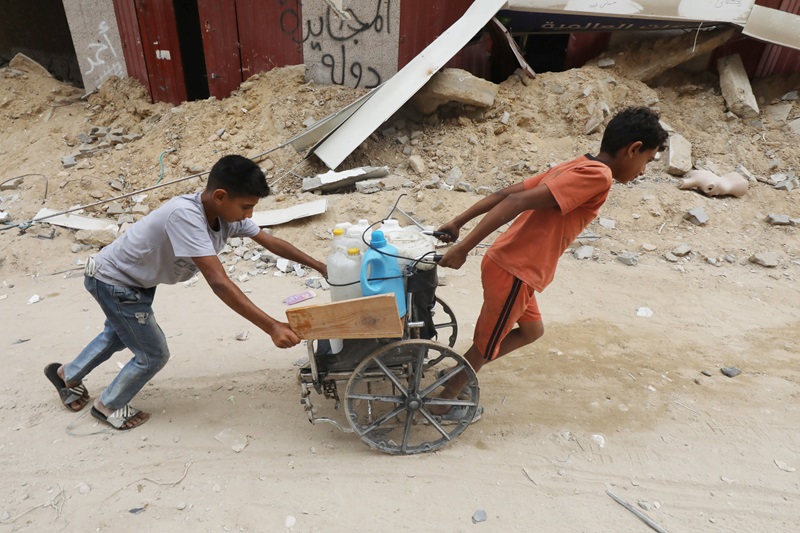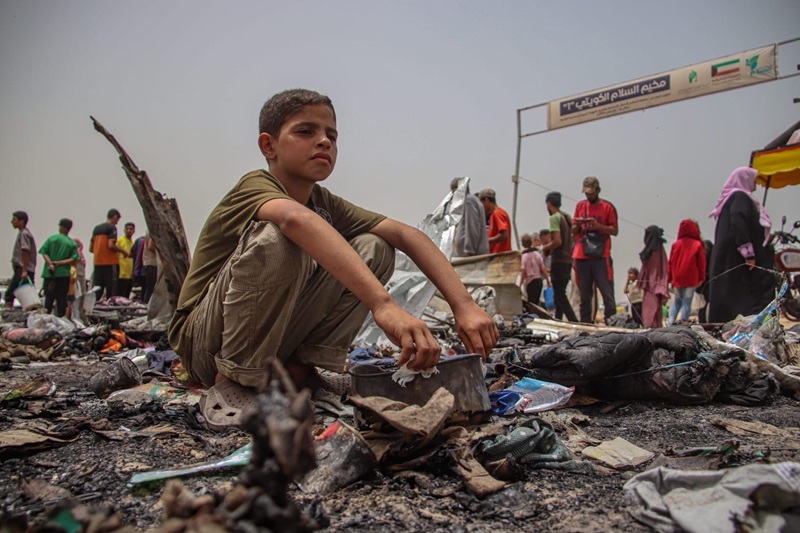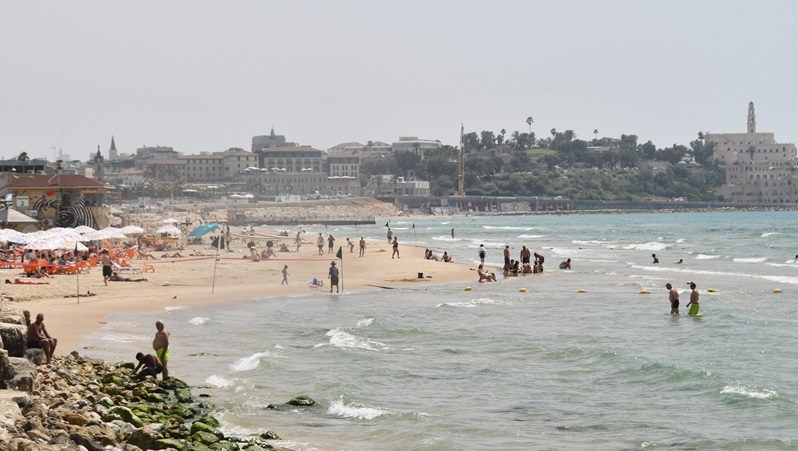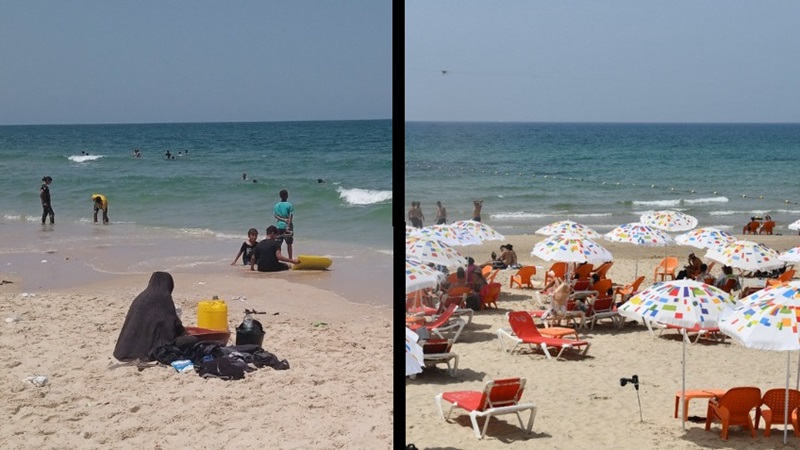While Palestinians in Gaza fear death from heat in makeshift tents, Israelis in Tel Aviv stay cool in air-conditioned homes – highlighting the unequal effects of extreme weather
Throughout April and May, people across the Middle East and much of Asia have suffered from record-breaking heatwaves, which have been made more frequent and more severe by climate change.
But not everyone has been affected equally, as Climate Home found out when speaking to people living by the Mediterranean Sea, just an hour or two’s drive apart. The Israeli city of Tel Aviv has been largely unscathed by the ongoing war between Israel and the Palestinian militant group Hamas, while Gaza’s urban areas have been bombed heavily, forcing most residents to flee Israeli attacks.
Climate Home spoke to two Palestinian fathers, now living in Gazan refugee camps in Rafah and Deir al-Balah, who have lost children to the recent heatwave. Both had fled their homes before their children died and are living with their surviving families in makeshift wood and nylon tents, fanning themselves with plastic food containers for ventilation.

Boys carry water bottles in Gaza on May 28, 2024. (Photo: Naaman Omar)
Meanwhile, just to the north, on the beach-side promenade of Tel Aviv, Israeli locals told Climate Home they had waited out the heatwave in air-conditioned apartments. Their main concerns were the cost of cooling, the strain it places on the country’s electric grid and drooping house plants.
Not just temperatures
Friederike Otto is one of the scientists who worked on a study issued by the World Weather Attribution group which found that climate change made the April heatwave in the Middle East five times more likely.
She told a press briefing that heatwaves are “not just about the temperatures – it’s what these temperatures mean to people”.
Asked separately about Gaza, she told Climate Home: “If you don’t have access to water, if you don’t have access to shade, if you don’t have access to medication – the extreme heat just compounds so much the challenges that these people are already facing.”

The Gaza Strip, one of two Palestinian territories, is just 25 miles long and about five miles wide. Since a bloody attack by Hamas on Israeli civilians on October 7, the Israeli military has repeatedly bombed and invaded Gaza, killing over 35,000 people.
The attacks have caused 1.9 million people, nearly 85% of the Gazan population, to flee their homes. While air conditioning, electricity and clean water have long been scarcer in Gaza than Israel, the current conflict has worsened that inequality, development agencies have said.
Greenhouse tents
Many refugees are living in nylon tents. Without walls, fans or air conditioning, they told Climate Home they are battling heat by using expensive water to shower as often as they can and stripping children – nearly half of the region’s population – to their underwear.
“It is like living in a green house, and no one can tolerate living inside.”
We are just at the beginning of summer, and the temperatures are already unbearable in #Gaza
Access to fresh water is very limited, making hot weather an even bigger health threat#CeasefireNow pic.twitter.com/6Qtln9XPD0
— UNRWA (@UNRWA) April 25, 2024
Hilmi Basal, 41, and his wife and six children left their home in northern Gaza after Israeli warnings. They fled south, buying a makeshift tent to live in the Deir al-Balah refugee camp. On April 26, Basal said, his three-year-old son fell suddenly to the ground and entered a coma. Five days later, he was pronounced dead in the local hospital.
Basal told Climate Home he “lives a difficult life” after losing his child, feeling “despair, frustration and fear of losing more children”. He said the tents are like greenhouses, so his family spend their days outside, preferably at the seashore where they can swim and shower.
He and his wife dress their five surviving children in only their undergarments and search for water to cool down. A 20-litre bottle of drinking water costs $1.50, which Basal says “is an amount that many families suffering from extreme poverty do not have”.

A boy sits in a bombed-out area of the Rafah refugee camp after an attack by Israeli bombers in Gaza – May 27, 2024 (Photo: Hashem Zimmo/TheNews2/Cover Imag)
Ribhi Abu Salem, 39, also lost a child to the heatwave. The three-year-old fainted suddenly while he was inside the family’s tent and died at the hospital. Doctors said the cause of the death was direct exposure to sunlight.
Until Israel’s attack, the family lived in an air-conditioned house in the Jabalia refugee camp in northern Gaza. This was built for Palestinians fleeing what they call the Nakba (meaning “catastrophe”) in 1948, when Zionist paramilitaries violently removed Palestinians from the newly-declared Israeli state.
Advised by the Israeli government to leave northern Gaza, Salem’s family fled south to the city of Rafah, where they sheltered in a tent. “Despite the scarcity of water, many tent residents resorted to buying large quantities of water to shower more than five times during the day,” Salem said.
After his family left, the Israeli government bombed their home, leaving them with nowhere to return to when the conflict ends. On May 6, Israeli forces began attacking Rafah and have since killed dozens of people sheltering there.
“It’s difficult to convey the scale of the humanitarian situation in Rafah. In every direction you look there are makeshift shelters.”@UNWateridge describes the sense of loss & fear people face in #Gaza as they look for water, food & safety.
Nowhere is safe in the #GazaStrip pic.twitter.com/OpH2YV7avk
— UNRWA (@UNRWA) April 25, 2024
For those with homes still standing, the usefulness of air conditioning and fans has been hindered by Israel’s blocking of fuel supplies to Gaza’s only power plant, leading to shortages of electricity. Solar panels continue to provide power for some, although they are also vulnerable to destruction by Israeli weapons.
AC the key
Across the border, Israelis are coping much better with the heatwave. Although the emergency services say 147 people have been treated for dehydration, fainting or heatstroke, none have been reported dead from the extreme heat.
When Climate Home visited Tel Aviv’s seaside promenade last week, beach-goers were sitting under umbrellas or stretched out on lawns listening to Spanish music blaring from a bar advertising frozen margaritas.

The beach in Tel Aviv on May 23, 2024 (Photo: Jessica Buxbaum)
Twenty-somethings Noam Sophia Samet and Tal Danon spoke to Climate Home still wet from a dip in the Mediterranean Sea. Both said they use air conditioning all the time. “It’s expensive but it’s worth it,” said Samet.
Timna Lalach, 70, said last month’s heatwave didn’t affect her, as she stayed inside her cooled apartment all day. Thirty-nine year old Anna Tarkovsky said she too stayed inside with the air conditioning on – the only problem was her plants died, she added.
Black-outs
While Gazans lack air conditioners, Israel’s main issue is that there are too many for it
Read More

